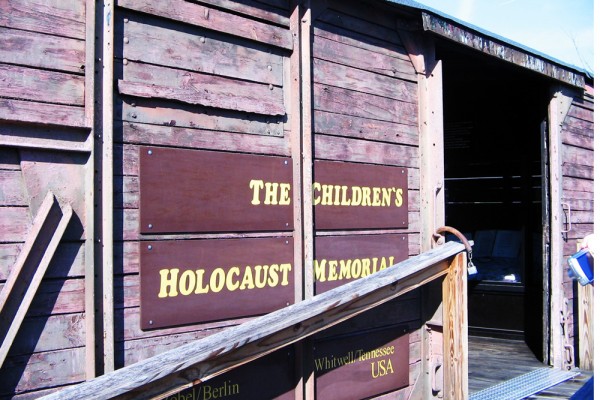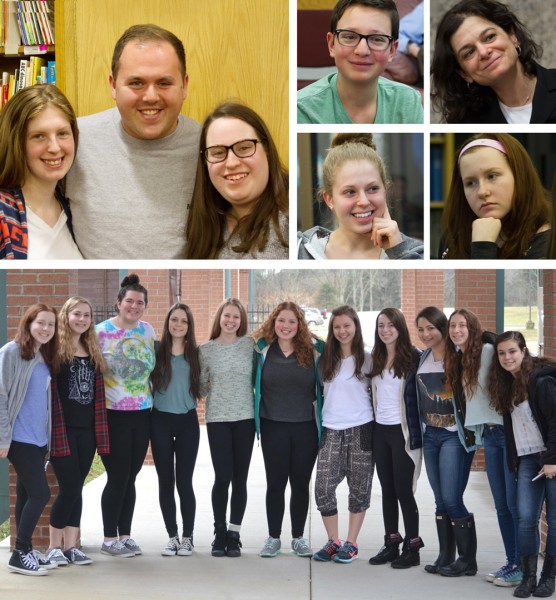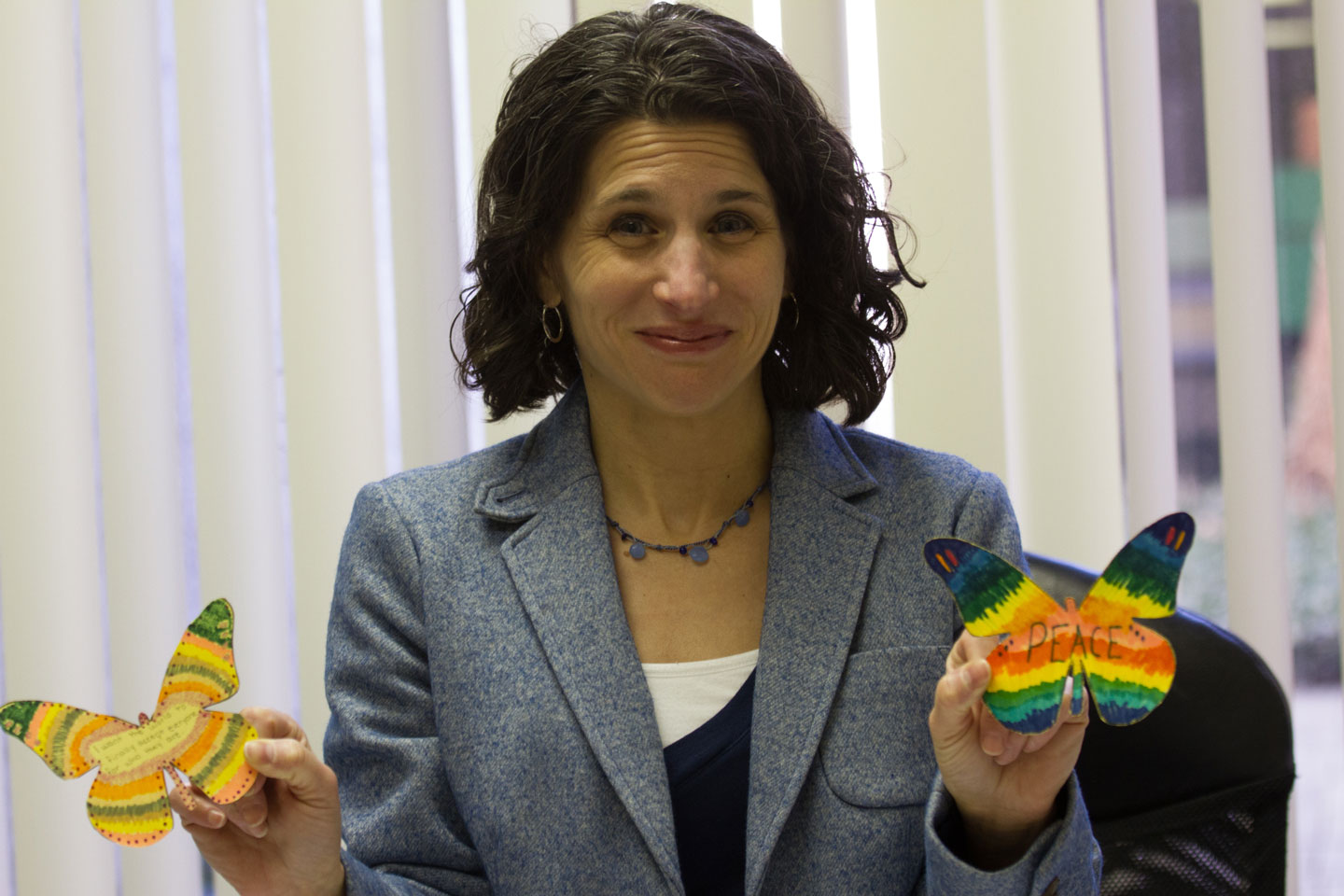The Paper Clips Project Revisited
By Vivian Henoch, Editor myJewishDetroit
April 1, 2015
What do we talk about when we talk to young people about the Holocaust?
Consider a family trip to Whitwell, a once thriving mining town nestled in the Sequatchie Valley, 24 miles from Chattanooga, Tennessee. Population about 1,700. Along Highway 28 running through the center of town, you’ll find one stop light, the Coal Miner’s Museum, a mom-and-pop pizzeria, a Save-A-Lot Foods store and on a clear day, a great view of the mountains as you turn on to Valley View Highway towards Butterfly Lane, to Whitwell Middle School, home of the Children’s Holocaust Memorial.

Whitwell Middle School is as unlikely a place as any to have become the site of a world acclaimed Holocaust museum, let alone the recipient of one of the last remaining “cattle cars” of the Nazi era. But the story of what happened in that small rural town has inspired millions around the world to share their stories of courage, survival and hope.
“Be grateful for what you have; you’ll find you have more than you can ever imagine.” Maggie Leff, 10th grader
The Paper Clips Project
It all started in 1998, when Whitwell Middle School principal Linda Hooper prompted language arts teacher Sandra Roberts and associate principal David Smith to teach the school’s largely white and Christian students from low income families about the Holocaust as the basis of a voluntary after-school program exploring the issues of hate and intolerance.
As the class struggled to grasp the massive scale of the Holocaust and the sheer numbers of the Jews who lost their lives, one student raised his hand with the question: six million? The number was incomprehensible. How was it possible to understand? Smith’s response was inspired: why not collect something of historical significance to tangibly represent the six million – one for each life? Through internet research, the class discovered that collecting paper clips would offer a symbolic and profound dimension to the project, given that Johan Vaaler, a Norwegian Jew, invented the paper clip, and that Europeans wore paper clips on their lapels during World War II as a silent protest against the Nazi occupation.
While the goal was to collect six million paper clips – one for each soul who perished during the Shoah – the project attracted media attention and support worldwide. Letters and emails started to flood in with donations . . . more paper clips than anyone could have imagined.
“My favorite part of the trip was spending time at the synagogue because everyone was so nice and it felt like home.” Zoe Weil, 9th grader
As Jodi observed, “Most of us are here today by some miracle.
Jewish notables, celebrities and survivors sent paper clips with notes, photos and family treasures in remembrance of loved ones. The “Paper Clips Project” extended over several years and, in 2001, the school dedicated a Children’s Holocaust Memorial, which includes an authentic German railcar filled with six million of the more than 30 million paper clips they collected, along with over 30,000 letters that are available for viewing at the Memorial. Today the school routinely hosts visitors, tours, Holocaust survivors and guest speakers from far and wide. A moving documentary, entitled Paper Clips and originally released theatrically in 2004, captures how these students responded to lessons about the Holocaust and how a committed group of children and educators provided hope and inspiration to countless others around the globe.
Enter Congregation Adat Shalom
With warm memories of their first visit to Whitwell Middle School leading a group of eighth graders in 2007, Adat Shalom’s Rabbi Rachel Lawson Shere and Associate Director of Education and Youth Jodi Gross recently had the opportunity to take a second group to Whitwell, thanks to a generous donor who underwrote the weekend excursion for a 28 teens from grades 8 to 12. The rabbi and Jodi felt the trip was such an amazing experience that they also welcomed teens from other Conservative congregations.
In preparation for the trip, participants were encouraged to attend a five-week class on the Paper Clips Project. Additionally, they met at the synagogue to discuss the logistics of the trip and some of the background history, touching upon the concepts of resistance and peaceful protest during the Holocaust, as well as how to bring what they experienced home.
“I loved meeting and getting closer to new people. I also learned what it really means to be part of a Jewish community.” Maddie Katz, 8th grader
Describing the town of Whitwell, Rabbi Lawson Shere reminded the teens how extraordinary it was “that a city where kids who had never even heard of a Jewish person — let alone met someone Jewish — decided to take it upon themselves to do something to remember the Jewish people in such a moving and lasting way. One of the things I want you to be thinking about on this trip is what can we be doing? Where can we look out at the world and see others who currently may be experiencing some kind of oppression?”
Some miracle had to have happened in our families for our grandfathers or great great grandfathers to escape tragedy. Somewhere along the way, everyone here has family who came at the right time and place so you can be here today.”
“I love that we have the opportunity to be in Whitwell together,” Rabbi Lawson Shere added, “I hope that we can all get to know each other better and look out for one another, like brothers and sisters.”
Serving as chaperones for the trip, and adding their perspective as participants on the original Adat Shalom Paper Clips trip in 2007, were college students Lexie Sittsamer, a junior at Western Michigan University, and Nate Straus and Ilana Woronoff, both juniors at Michigan State University.

Recalling the impact of that first trip, Nate described his experience viewing the railcar, “As I peered through the protective glass, looking through the millions of metal shapes, I noticed one single red paper clip. To me, that clip represented the work that I must do for the rest of my life, as a Jew, a human being and a citizen of the world. Seeing those paper clips, thinking about each and every person they represented struck me like a lightning bolt.”
I was so moved when we were all standing inside the boxcar and said the Mourner’s Kaddish for all who died. This trip has truly changed my life. Brittany Diskin, 12th grade
“We’re still unpacking our responses to the trip,” Jodi stated as she described some of the other highlights of the weekend, which included:
- Reading the letters sent to the Memorial. The students were dismayed to see so many letters from Holocaust deniers.
- Running into local celeb Sandra Roberts (the teacher who started it all) at lunch and giving her a standing ovation
- Shopping at George’s Grocery for donations to the Whitwell Food Pantry, with the owner disclosing that our purchases were his largest sale in a month
- Celebrating Shabbat at B’nai Zion Congregation in Chattanooga and discovering a warm and welcoming community
- Friday night home hospitality provided by members of B’nai Zion in Chattanooga
- The variety of unplanned moments where students stopped to think about what impact they wanted to make on others, our community and the world
- The classes before the trip helped the students prepare and classes after brought them together to continue building community and think about their experiences on the trip and how to bring them home.




